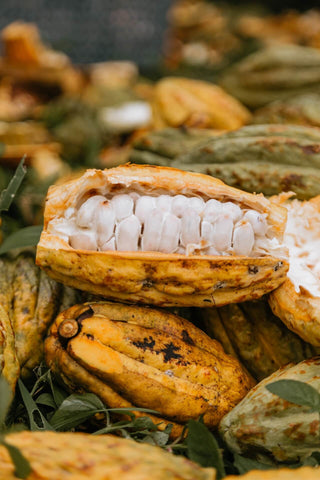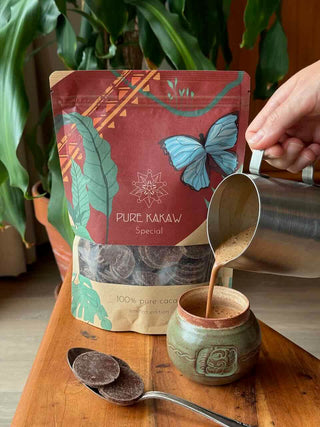Cacao takes up nutrients and elements from the soil. Also toxic heavy metals that naturally occur in nature. This is why we test our cacao on heavy metals like cadmium and lead in an independent lab. We want to enjoy cacao that is safe and healthy on a daily basis. So we take extra care when selecting cacao.
In this results table you can see that the cadmium and lead contents of our cacaos are very low and fall far below EU regulations. We’ll explain more about this below and put things into perspective.
| Cusco | Alta Verapaz | Matagalpa | Cahabón | Strictest regulations | |
| Cadmium | 0,046 PPM | 0,369 PPM | 0,194 PPM | 0,26 PPM | 0,800 PPM [EU] |
| Lead | <0,05 PPM | <0,05 PPM |
<0,05 PPM |
0,225 [Prop 65] |
PPM = parts per million or µg/g
Explaining these numbers and regulations.
Because of the toxicity, governments put regulations in place (luckily!) to allow a maximum concentration in different food sources. The concentrations are usually measured in parts per million (PPM) which is the same as 1 millionth gram per gram. We looked at the strictest standards in the world. For cadmium that is the EU regulation and for lead that is the California Prop 65.
For lead there is no maximum EU regulation for cacao. The California Prop 65 is one of the strictest food regulations and states a max of 0,225PPM for lead in cacao. Interestingly the Prop 65 is less strict than the EU for cadmium (0,960PPM). To establish these concentrations the amount is researched from where developmental toxicity can occur. This amount is divided by one thousand to build in serious safety margins.
Our Cusco and Matagalpa cacaos have such low cadmium content that they even comply with fresh fruits and vegetables (0,05-0,2 depending on the sort) of which you would consume much more than the amount of cacao in one drink. For lead all our cacaos have such low concentrations.
Note that in chocolate products cacao with higher concentrations of cadmium and lead can be used as they are diluted with sugar and other ingredients for the final product. The EU regulation is for 50% and higher cacao contents.
Why you want to avoid toxic heavy metals in your system.
Heavy metals are naturally occurring in nature, so you will always find them in food and the environment, it is impossible to fully avoid. Cadmium and lead are toxic heavy metals and can cause damage when being exposed to a higher dose over time. Especially for babies and infants compared to adults. A link is made between cadmium and neurodevelopmental defects in children, birth defects, kidney problems and oxidative stress. It is also classified as carcinogenic when inhaled (smoking and contaminated environment), which is not the case for food.
The problem is that cadmium accumulates in the body (particularly in the liver and kidneys) and is difficult to lose.
How it ends up in our food.
Heavy metals naturally occur in the earth’s crust and plants obtain it from the soil and their environment. Cacao is just one of them, but other food sources contain much higher levels as they uptake much more from the soil.
Some factors that influence cadmium and lead content in cacao are: the geographical location, the soil acidity, cacao variety, use of fertilizers, mining, burning of gasoline and garbage, and drying cacao next to a road.
Cadmium is mostly obtained by the tree from the soil.
Lead is more often obtained as contamination after harvesting, during handling and processing. Therefore the highest concentrations of lead are found in the husks of cacao, but a part also gets to the seed within the husk. All our cacao is peeled and we take out the husks to make our cacao paste.
To put things into perspective.
We know heavy metals in cacao gained much attention as it is a scary thing to find out that something so healthy can also contain cadmium and lead. The reality is that toxic heavy metals naturally occur in the environment and other plants and food are larger sources (for example carrots, green beans, sweet potatoes and spinach). We all want to eat healthily, it is worthwhile looking for high quality food and to consume a healthy variety. Luckily there are regulations, like the EU made for all kinds of food products. Our bodies can handle some heavy metals, it’s about avoiding larger amounts over time. So it might be interesting to look into heavy metals in other food sources too. We do our best to keep offering high quality and safe cacao for you to enjoy!
Sources if you want to dive deeper into it:
Cadmium in Chocolate - EU Commission
The Effects of Cadmium Toxicity, 2020
Regulation No 1886/2006, EU Commission
Cadmium Exposure and Potential Health Risk from Foods in Contaminated Area, 2016















